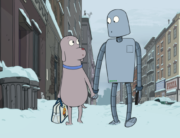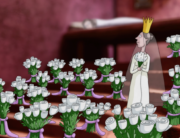Like MetLife and its commercial use of Snoopy, Laurie Anderson deploys her cute canine as an entry point to mull a subject people usually avoid thinking about: death. The depiction of the life and 2011 death of her rat terrier, Lolabelle, at first seems like those endless photos of and commentary on beloved pets posted by my childless Facebook friends that show up on my newsfeed. (Anderson even dreams of giving birth to Lolabelle.) However, her narration moves on in a stream of consciousness to other deaths that have recently touched her: her Midwestern mother, who died seven years ago; those in her Lower Manhattan neighborhood who died on 9/11; and her husband and the rock ‘n’ roll legend, Lou Reed, who died in 2013.
Heart of a Dog grew out of a short that was commissioned by a European TV network for a series on artists talking about the meaning of life and work. Anderson weaves her music, videos, photographs, drawings, and experimental images into an allegorical essay that is also a tribute to Chris Marker’s cat essays on politics and society. The animated section on the Tibetan Book of the Dead, with her musings on the potential of her dog’s soul in the afterlife, has an “Introduction to Buddhism” type of superficiality as it explains the 49-day transition between death and rebirth.
But her family memories are stunning dreamscapes through her distant and recent past, recounted by this master multimedia storyteller of the psyche. While her intellectual free associations to her favorite writers (such as David Foster Wallace), sculptor (Gordon Matta-Clark), and philosopher (Ludwig Wittgenstein) are not unexpected, Anderson is usually so associated with the avant-garde New York music and art scenes that her childhood experiences in a large outdoor-loving family add layers to her quintessential American identity. Like Garrison Keillor free associating about his fictional Lake Wobegon, she is moved by her mother’s last words and a cache of family photographs and home movies to think back to the sights, sounds, and smells of her childhood, including a forgotten memory of a brush with near-death. While her feelings are frequently presented in surreal abstractions, some of her remembrances and encounters are reenacted by the likes of her husband, singer Jenni Muldaur, and painter Julian Schnabel.
Finally leaving the dog as an allegory, her thoughts on Reed are bound up with their sharing the shock of 9/11. Th film is like an “answer song” to the notable “Song of the City” he wrote regarding those days, “Laurie Sadly Listening.” Running away from New York shortly after the terrorists attacks, she revels in the natural beauty of the California coastline and mountains, instead of wallowing in her personal loss. In doing so, she explores and celebrates the innocence and privacy all of us have since lost with added surveillance and data collection. The search dogs in Penn Station make her long all the more for the comfort and company of her departed Lolabelle.







Leave A Comment